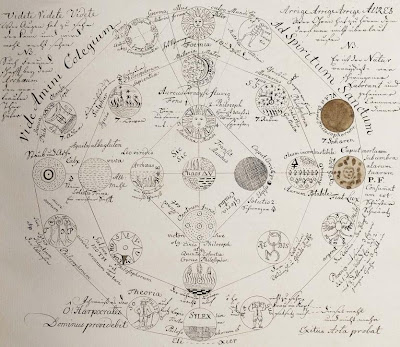











Johann August Starck [Stark] (1741–1816) was a Professor of both oriental languages and theology in St Petersburg, Königsberg and (mostly) Darmstadt. He was a prolific author, particularly noted for his studies of comparative religions.
Starck joined the Freemasons in France when he was about twenty years old. The story goes that when he was in Russia he met with a Rosicrucian who had been closely acquainted with a founder of a Masonic Lodge in Florence in the early 18th century. The founder was a collector of ancient manuscripts and that Lodge became a centre for Rosicrucian, alchemy and theosophical discussion and enquiry. Secret knowledge divined from the 11th century Knights Templar, as laid out in the manuscripts, greatly contributed to the founding of Hermetic traditions within the developing Masonic fraternity in Germany.
Starck appears to have been what you might call a significant player in German Freemasonry as a direct result of his being exposed to the Florentine teachings. He was a leader of a faction (oh yes, Life of Brian correspondences seem appropriate) called the Klerkikat which joined with the existing Knights Templar order of Freemasons, the Strict Observance, but a schism eventually developed due to Starck's peculiar brand of Masonic beliefs. He was accused of being a Catholic and became quite an unpopular figure despite his receiving plum academic and civil appointments (he was a colleague and friend of philosopher Immanuel Kant). Apparently many of the ideas formulated or advocated by Starck persist into modern day Freemasonry.
One of the more notable subjects of his authorship appeared in the 1803 book, 'Triumph of Philosophy', in which Starck:
"claimed that the Illuminati, a freemasonry group founded by Adam Weishaupt (1748-1830) in 1776, stood behind the French revolution and were secretly pursuing similar lawless and godless schemes in German lands and elsewhere."How does any of these conspiracy and esoteric shenanigans relate to the intriguing images in this post? The simple answer is: I'm not really sure. They appear in three manuscripts recently uploaded by Wolfenbütteler Digitale Bibliothek and all are attributed to Johann August Starck (or at least, they are listed under his name as author). It would seem they are either copies of, or notes and symbols dervied from, the renowned 'Geheime Figuren der Rosenkreuzer' (Secret Symbols of the Rosicrucians) from the late 18th century.
-Ms. Cod. Guelf. 454 Nov.
-Ms. Cod. Guelf. 455 Nov.
-Ms. Cod. Guelf. 456 Nov.
As you might imagine, background research about this topic is apt to lead a person to some 'interesting' websites to say the least, where everything from the world bank, Cagliostro and the twin towers make an appearance. Consequently I'm only going to recommend the Starck biography in the Immanuel Kant teaching site at Manchester College. Anyone with a deeper interest in all of this has already gone off on their own searching quests no doubt. Related: alchemy/'La Très Sainte Trinosophie'.



No comments:
Post a Comment